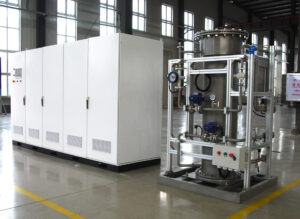Geralmente, water purifiers store the water in a water storage tank after purifying and filtering it. Due to the particularity of drinking water time, por exemplo, water treated at night may need to be stored in the water storage tank overnight before starting the next day. Portanto, there is a risk of bacterial growth, and additional sterilization and bacteriostatic steps are required before safe use. In this regard, ozone bacteriostasis has not been widely used due to its high technical and equipment requirements, but it has been recognized by the industry as a safe, reliable and pollution-free method.

There are two ways for ozone to act on pollutants in water. One is direct oxidation, aquilo é, ozone molecules directly interact with pollutants in water. In this process, ozone can oxidize some macromolecular natural organic matter in the water, such as humic acid, fulvic acid, etc., and can also oxidize some volatile organic pollutants and some inorganic pollutants, such as iron and manganese ions. Direct oxidation is slow and has certain selectivity, aquilo é, ozone molecules can only interact with organic pollutants or metal ions containing unsaturated bonds in the water. Another way is indirect oxidation. Ozone is partially decomposed to produce hydroxyl radicals that interact with organic matter in the water. The indirect oxidation reaction is very fast, non-selective, and can react with a variety of pollutants.
Research shows that the comprehensive effect of ozone pre-oxidation on water quality depends on a series of influencing factors such as ozone dosage, oxidation conditions, pH and alkalinity of raw water, and the types and concentrations of organic and inorganic substances coexisting in the water. Ozone pre-oxidation can destroy the unsaturated bonds of organic matter in water, reduce the molecular weight of organic matter, and increase the concentration of soluble organic matter DOC, specifically manifested as an increase in the concentration of AOC and BDOC, thus improving the biodegradability of organic matter. No entanto, the Ames experiment It shows that the partially oxidized intermediate products have certain mutagenic activity, and it is necessary to increase the ozone dosage to reduce the toxic activity of these products. For chlorination disinfection by-product precursors, ozone pre-oxidation can destroy it to a certain extent, or convert it into intermediate products with relatively low by-product formation potential.
The raw water is oxidized by ozone and then filtered by activated carbon. The macromolecular organic matter in the water is oxidized and decomposed into small molecular organic matter, which is easily absorbed by the activated carbon, improving the extraction rate of organic matter in the raw water. Além disso, ozone oxidizes the Mn2 in the water, making it The generated MnO2 is adsorbed on the surface of activated carbon and removed, thus making the raw water treatment effect better. The surface functional groups and pore structure of ACF are more developed than OAC, and it can adsorb organic matter and Mn macromolecules.
 gerador máximo de ozônio
gerador máximo de ozônio
